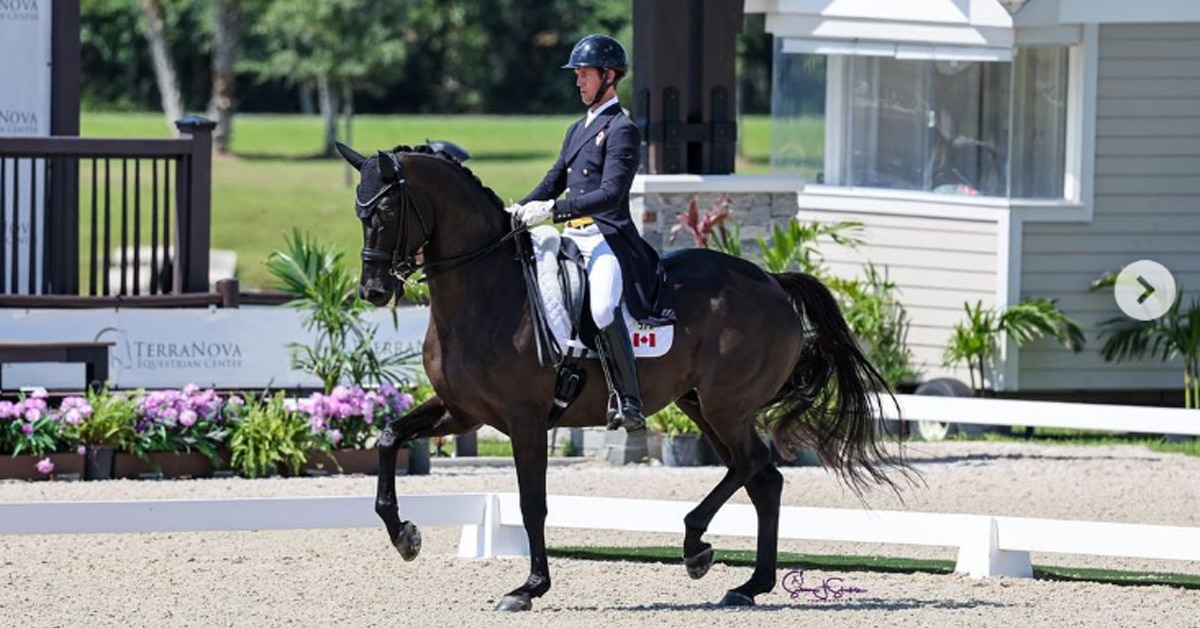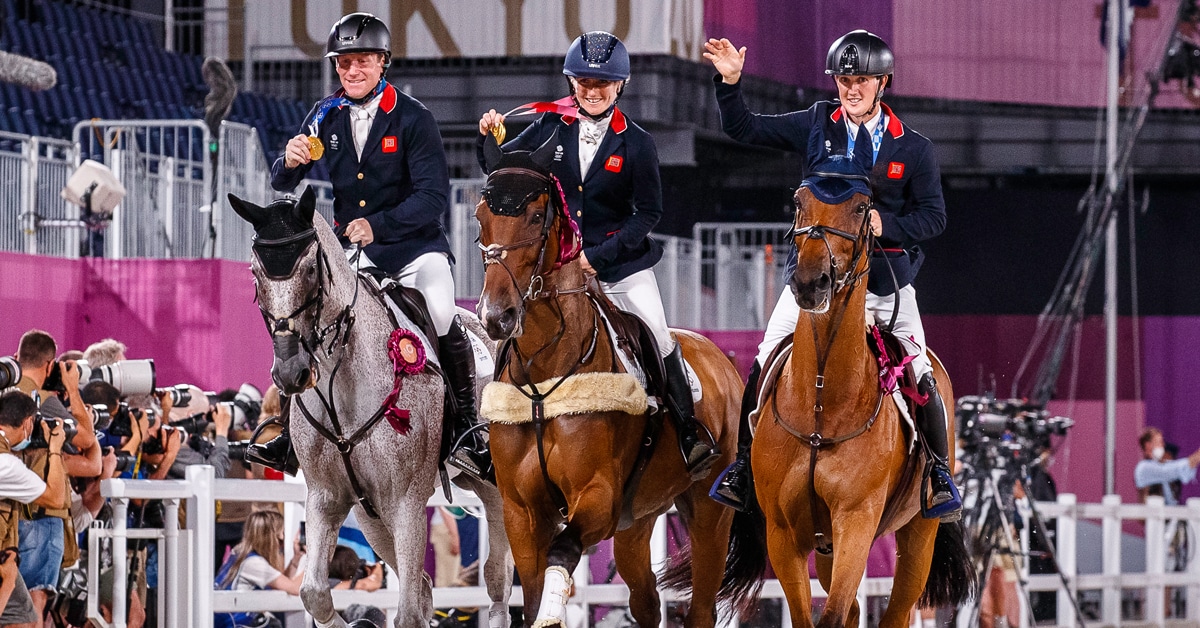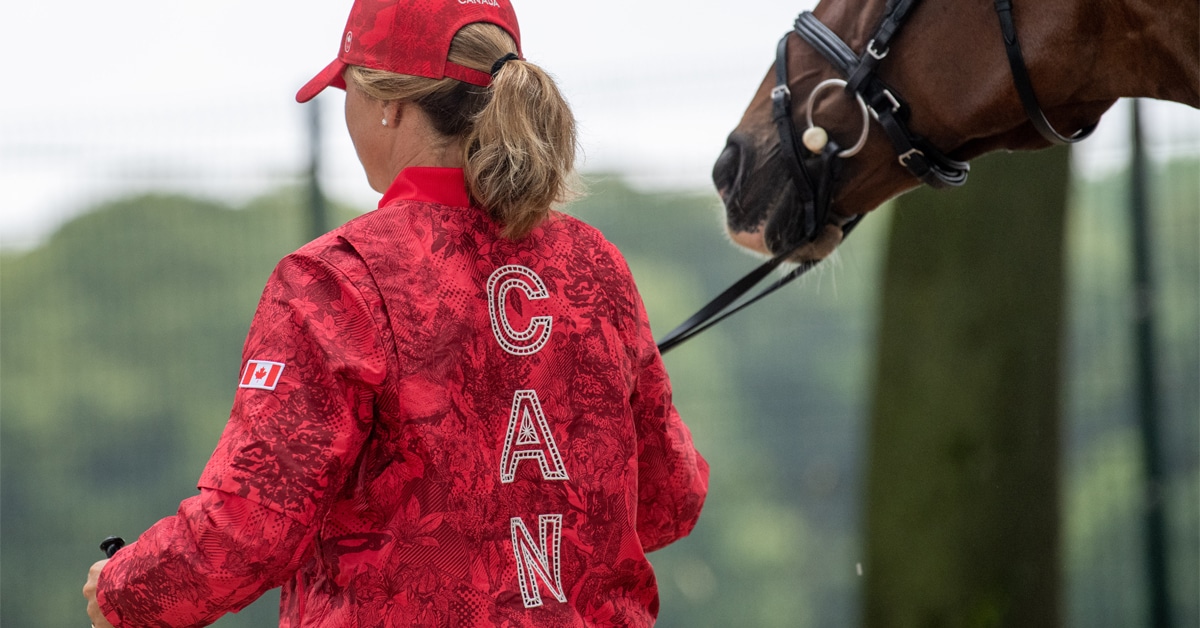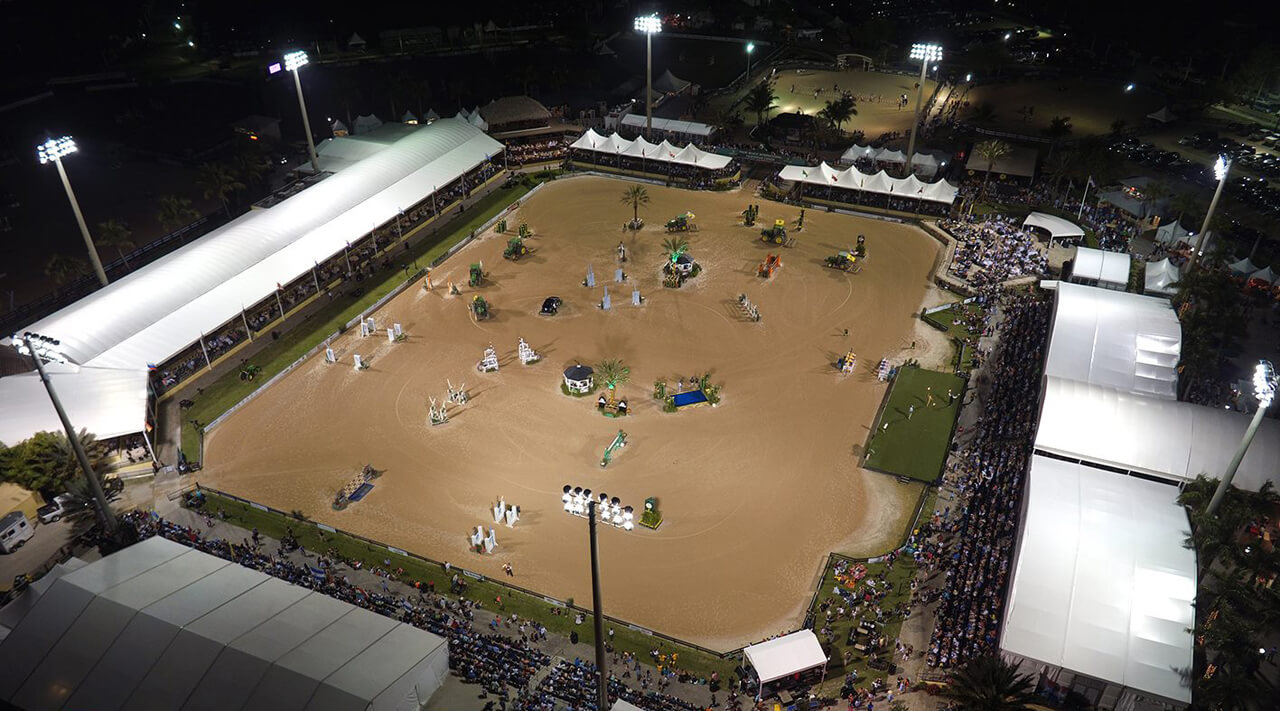In Europe the majority of the riders are still in full swing in the indoor season, but in Wellington they are about to start jumping in the sun… Here, at temperatures of 20 to 30° Celsius, the most fortunate riders jump for 12 weeks in one of the 13 arenas. And then we haven’t even counted the warm-up arenas. Welcome to Wellington!
Winter
With the start of the winter season, many large stables move to Florida… Not only because of the warmer temperatures, but also thanks to the beautiful accommodations: in addition to Wellington, riders can also jump in Ocala, Deeridge, Miami or one of the other national competitions.
Whoever enters Wellington is immediately surrounded by immense stables. Horses that compete in the FEI class must, just like in Europe, stay on site in the competition stables. Horses participating in the national classes or the hunter classes may be stabled at home or at the competition site. The WEF itself takes place for twelve weeks: from January 8 until March 29. If you want a permanent stable during this period, you pay $ 3,750 per stable for the entire period (around 3,360 euros). If you only come for a week, you even pay $ 450 per stable. However, renting an accommodation in the area is not much cheaper: prices range from $ 1000 to $ 2000 per stable per month! The rule is: the farther from the competition area, the cheaper, but of course the facilities also play a role.
However, the stable fee is not the only thing that cannot be compared with Europe, the entry fee is also very different. Anyone who participates in a CSI2* in Belgium pays an average of around 400 euros excluding VAT, in Wellington this quickly rises to $ 2,226 per horse excluding VAT, or a sloppy 1,995 euros. But just depositing this entry fee is not enough. Just like in Europe, the riders usually have to take a VIP table to compete at WEF. The VIP is divided into four rows with corresponding prizes: for 12 weeks on the top, and therefore last row, you pay $ 40,000, while the penultimate row costs $ 50,000, whoever wants to sit on the first or second row pays respectively $ 75,000 and $ 65,000!
But, let’s be honest: the prize money is also higher.. A 1m45 class in Mechelen distributes € 24,600 in prize money, while Wellington distribues $ 35,000 (€ 28,217). And that’s a difference of slightly more than 3,655 euros for the winner, because in Wellington usually 33% of the prize money is paid out to the winner, where in Europe this is mostly 25%. In the 1m60 classes this difference in prize money becomes even bigger: the Mechelen World Cup distributed € 179,008.26, while the 5* Grand Prix of Wellington is worth as much as $ 384,000!
Nice detail: during the CSIO4* the entry fee is only 600 $, which is very similar to the prices we pay in Europe. How can you explain such a big difference? American Nations Cups fall under the same rules as the European regulations, which means that the entry fee is the same as well!
For the national classes, the entry fee depends on the prize money. A $ 10,000 prize money class usually costs around $ 300 to enter. A 1m50 class with $ 25,000 prize money costs around $ 450. Anyone who competes in three classes, therefore, will easily have a $ 800 entry fee.
More differences than just the price tag
In terms of cost, there are already the necessary differences between Europe and America, but it doesn’t stop there… In Europe, amateurs and pros all jump in the same class, something that is usually not the case in America. In most classes you will be divided into amateur or professional. While in Europe, the word amateur sometimes has a bitter aftertaste, in The States that is absolutely not the case: you are an amateur if you are not paid for riding. In addition, you may not be sponsored. In practice, this means that amateurs almost always own their horses and that they are not allowed to work in a stable, even if that would only be as a bookkeeper…
Another big difference is the warm-up. In Belgium and the Netherlands, there are mostly two obstacles (or three if you are lucky) available for all participants, where we all jump the same vertical and oxer, mostly on the left hand side. It’s possible to start jumping 20 horses in advance, but if you want to wait for 4 horses in advance, then this is also perfectly possible. In America that is slightly different. There are usually 4 obstacles in the warm-up, all of which can be converted to oxers. You will be assigned your own fence around five combinations before you have to start. That means that you can only use this obstacle. No one else can jump over it. You also decide for yourself whether you want to use the jump on the left or right side or even on both sides. It is all allowed, just as long as the flags at the top of the jump are exchanged. Do you want to change the vertical to an oxer and a jump later a vertical again? You can do as you please! The system clearly provides the necessary comfort, because you don’t have to take anyone into account. If you have a horse that thinks it is scary to jump on the outside, you can even ask the steward if they’ll assign you another fence. As soon as you are done, you report this to the steward and he will then assign the obstacle to the next participant on the starting list.
A fourth difference is the use of medication and doping. At the national competitions, little account is taken of the FEI rules regarding medication. Whether that is much better is left unanswered, but the fact is that even phenylbutazone (also known as Buut in popular speech) may be given to the horses. That intake is limited to 1 gram per day, but is more than sufficient to make small problems invisible. In addition, the soils are not made from geopad but from a sort of firmer grain, making the footing a lot harder than ours in Europe. This ensures that in addition to the painkillers, the horses also regularly have to deal with injuries. Despite the more supple use of medication and doping, there are many doping controls!
Palm Beach International Equestrian Center
The domain where the Winter Equestrian Festival takes place is called Palm Beach International Equestrian Center. PBIEC covers a total of 202 hectares and consists of “The Stadium” and the “Main Ground”. The “Main Ground” is the part where the jumpings take place and this is also the location where there are 13 arenas (without warm-ups!) to be found. There are 256 permanent stables on the Main Show Grounds, but there are many more tents. Not surprising, as there are on average around 2000 combinations per week competing at the WEF! “The Stadium” is a bit further and holds mainly dressage competitions. The world’s largest indoor arena (110 x 64 m) can also be found on these 24 hectares. In addition to the dressage rings, there is also a grass derby area and there are another 200 permanent stables. PBIEC has been operated by ESP since 2006, also known as Equestrian Sport Productions LLC, and has experienced a strong growth ever since. Mark Bellissimo is the CEO of ESP and invested in addition to Palm Beach International Equestrian Center also in The Colorado Horse Park and in Tryon International Equestrian Center, where the World Equestrian Games were held in 2018. In addition to the many horse facilities, Bellissimo and his partners also invested in the rest of the Wellington area: they are the owners of the International Polo Club and also of The Wanderers Club, a private sports club with a large golf course.
Most spectators can be found at PBIEC on Saturday evening. Then there is always a Saturday Night Lights event. It is a class that starts in the evening and where people jump in the artificial light. Before the class, there is usually a performance or some kind of show, which attracts a large number of spectators. On average, around 6,000 people come to watch on Saturday evenings, many of which are not even into horses, but simply live in the neighborhood or are on vacation.
Despite the impressive size and luxury that Wellington has to offer, no World Cup takes place. Filip de Wandel, owner of Five Way Farm, told us why: “Rolex is the main sponsor of PBIEC, while the world cup has been sponsored by Longines for several years. That is why they decided to not hold a world cup anymore at PBIEC. An opportunity that was gladly seized by Deeridge Farms, which is a few kilometers away. They now hold a CSI3* World Cup. Another consequence is that the CSIO4* Nations Cup held in PBIEC does not count for points. That means that one cannot qualify to participate in the final in Barcelona here. The Nations Cup that is held in Deeridge counts for that instead. ”
Filip de Wandel has been living in America for 8 years now. He is originally from East Flanders in Belgium. As a young man, he made the famous stallion Clinton complete his first competitions in the Belgian Cycle when he was employed by Hubert Hamerlinck. After a few intermediate stops, Filip opted for an independent career. He then worked closely with Lieven Devos, who also coached him and took him to America. There he met his wife Eliza Lehrman. “When I traveled to Florida with Lieven, I met Eliza and one thing led to another. At the start of our relationship I first lived in America for a year. Unfortunately, that wasn’t exactly what I expected and I got homesick. Then Eliza came to live with me in Belgium for 2 years. Eventually it had to be decided where we would start our base and that has become America.”
“In Florida we rent our stable. In Pennsylvania, where we stay during the summer, the stable is in our property,” Filip explains. “Although our farm in Pennsylvania has the necessary land, we continue to raise our horses in Belgium. That is partly because it is all a bit more expensive here in the States: higher stabling costs, higher entry fees, more expensive blacksmith, etc. The upside of that medal is of course that there is more prize money and that you can also ask more money for training. On average, people here pay around 3 to 4,000 euros to put their horse with a trainer. That may include the costs of stabling, but then you haven’t jumped a single competition yet… A day at the show, shows us that the quality of the horses at the competitions in America is higher. That has several reasons, says Filip: “In Belgium, it is affordable for an ordinary man to breed and even train horses. There are enough riders who only ride the horses at competitions, without asking a lot of money and also the entry fee is easily affordable. In addition, there are many people who compete for the hobby and breed themselves and thus participate in the 1m30 classes. Due to the much higher costs in America, that is not the case here. In addition, there is little breeding here, which means that most horses are imported. Importing a good or a bad one is equally expensive (around 10,000 to 15,000 euros) and people do not put all that effort into an average horse. These facets together ensure that on average there are better horses in America than in Belgium: they have already been selected. In Belgium I mainly rode young horses for owners and breeders, and then the training was sometimes economical. Here the mentality is different: almost everyone invests here in a trainer and the training, for both the riders and the horses, receives a lot of attention. Because most riders are amateurs here, the training is also very important. They can do little with “problem horses.” Control and training is key! ”
Young horse cycle
Although education is important, there is no real cycle for young horses in America. Yet there are competitions for young horses (from 5 years old) where they can jump for points. Also for the 4-year-old horses, a competition is occasionally organized, although the numbers remain scarce. The heights for the young horses are comparable to Europe and there is also a real championship for young horses. “That championship is arranged privately,” Filip explains. “The federation was not so interested in organizing this, so someone decide to set up some sort of circuit. That means that the organization is less professional, certainly in relation to the Belgian concept. For a long time the championship had its final in a big competition in the Hamptons, but the last few years the final was held in different places. As a result, it is now less appealing. Many good riders appeared at the start in the Hamptons, who consequently then took their good young horses if they had them.”
More from News:





